
The USS Enterprise was a schooner, built by Henry Spencer at Baltimore, Maryland, in 1799. Her first commander thought that she was too lightly built and that her quarters, in particular, should be bulletproofed. Enterprise was overhauled and rebuilt several times, effectively changing from a twelve-gun schooner to a fourteen-gun topsail schooner and eventually to a brig. Enterprise saw action in the Caribbean, the Mediterranean, and the Caribbean again, capturing numerous prizes. She wrecked in July 1823.
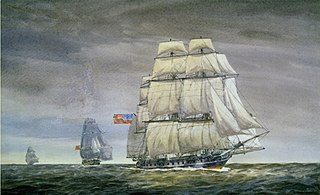
USS Adams was a 28-gun (rated) sailing frigate of the United States Navy. She was laid down in 1797 at New York City by John Jackson and William Sheffield and launched on 8 June 1799. Captain Richard Valentine Morris took command of the ship.

USS Ranger was a sloop-of-war in the Continental Navy, serving from 1777–1780 and the first to bear her name. Built at Portsmouth Naval Shipyard on Badger's Island in Kittery, Maine, she is famed for the solo raiding campaign carried out by her first captain, John Paul Jones, during naval operations of the American Revolutionary War. In six months spent primarily in British waters, she captured five prizes, staged a single failed attack on the English mainland at Whitehaven, and caused Royal Navy ships to be dispatched against her in the Irish Sea.
The first USS George Washington was a frigate in the United States Navy. She was named after United States Founding Father and President George Washington.
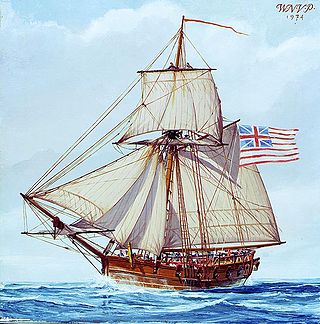
USS Providence was a sloop-of-war in the Continental Navy, originally chartered by the Rhode Island General Assembly as Katy. The ship took part in a number of campaigns during the first half of the American Revolutionary War before being destroyed by her own crew in 1779 to prevent her falling into the hands of the British after the failed Penobscot Expedition.
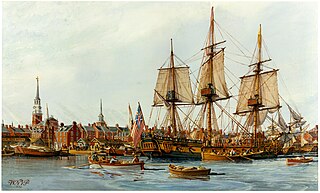
Alfred was the merchant vessel Black Prince, named for Edward, the Black Prince, and launched in 1774. The Continental Navy of what would become the United States Navy acquired her in 1775, renamed her Alfred after 9th century English monarch Alfred the Great, and commissioned her as a warship. She participated in two major actions, the battle of Nassau, and the action of 6 April 1776. The Royal Navy captured her in 1778, took her into service as HMS Alfred, and sold her in 1782. She then became the merchantman Alfred, and sailed between London and Jamaica.

HMS Galatea was a fifth-rate 32-gun sailing frigate of the British Royal Navy that George Parsons built at Bursledon and launched in 1794. Before she was broken up in 1809 she captured numerous prizes and participated in a number of actions, first in the Channel and off Ireland (1794–1803), and then in the Caribbean (1802–1809), including one that earned her crew the Naval General Service Medal.

HMS Indefatigable was one of the Ardent-class 64-gun third-rate ships-of-the-line designed by Sir Thomas Slade in 1761 for the Royal Navy. She was built as a ship-of-the-line, but most of her active service took place after her conversion to a 44-gun razee frigate. She had a long career under several distinguished commanders, serving throughout the French Revolutionary Wars and the Napoleonic Wars. She took some 27 prizes, alone or in company, and the Admiralty authorised the issue of four clasps to the Naval General Service Medal in 1847 to any surviving members of her crews from the respective actions. She was broken up in 1816.
John Peck Rathbun (1746–1782) was an officer in the Continental Navy and in the United States Navy. Rathbun was from Rhode Island with family in Boston. Rathbun served in the Continental Navy from its late 1775 beginning as John Paul Jones First Lieutenant.

The second Hancock was one of the first thirteen frigates of the Continental Navy. A resolution of the Continental Congress dated 13 December 1775 authorized her construction; she was named for the patriot and Continental congressman John Hancock. In her career, she served under the American, British and French flags.
USS Saratoga was a sloop in the Continental Navy. She was the first ship to honor the historic Battle of Saratoga. Having disappeared in 1781, her fate remains a mystery.
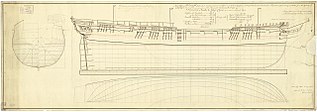
HMS Naiad was a Royal Navy fifth-rate frigate that served in the Napoleonic Wars. She was built by Hall and Co. at Limehouse on the Thames, launched in 1797, and commissioned in 1798. She served in the French Revolutionary and Napoleonic Wars, and her last actions occurred in 1824–5. She was paid off in 1826. She then served for many years in Latin America as a coal depot, first for the Royal Navy and then for the Pacific Steam Navigation Company. She was broken up in 1898, 101 years after her launching.

Révolutionnaire, was a 40-gun Seine-class frigate of the French Navy, launched in May 1794. The British captured her in October 1794 and she went on to serve with the Royal Navy until she was broken up in 1822. During this service Revolutionnaire took part in numerous actions, including three for which the Admiralty would in 1847 award clasps to the Naval General Service Medal, and captured several privateers and merchant vessels.
The second Providence, a 28-gun frigate, built by Silvester Bowes at Providence, Rhode Island, by order of the Continental Congress, was launched in May 1776.
USS Warren was one of the 13 frigates authorized by the Continental Congress on 13 December 1775. With half her main armament being 18-pounders, Warren was more heavily armed than a typical 32-gun frigate of the period. She was named for Joseph Warren on 6 June 1776. Warren was burned to prevent capture in the ill-fated Penobscot Expedition in 1779.
HMS Ariel was a 20-gun Sphinx-class sixth-rate post ship of the Royal Navy. The French captured her in 1779, and she served during the American Revolutionary War for them, and later for the Americans, before reverting to French control. Her French crew scuttled Ariel in 1793 to prevent the British from recapturing her.

HMS Camilla was a Royal Navy 20-gun Sphinx-class post ship. Camilla was built in Chatham Dockyard to a design by John Williams and was launched in 1776. She served in the American Revolution, the French Revolutionary Wars, and the Napoleonic Wars, before being sold in 1831.
His Majesty's Hired armed lugger Duke of York served the Royal Navy from 14 October 1794 to 2 January 1799 when she foundered in the North Sea.
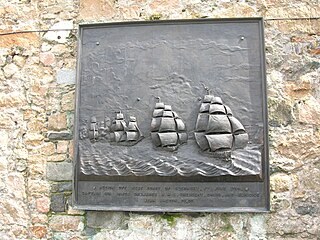
His Majesty's hired armed lugger Valiant served the Royal Navy on a contract from 5 May 1794 to 10 November 1801. She was of 109 90⁄94 tons (bm), and was armed with eleven 3-pounder guns.

Comet, an American schooner, was built in 1810 at Baltimore, Maryland. She was owned by "a group of wealthy Baltimore investors." Under Captain Thomas Boyle, who was a part owner of the schooner, Comet sailed from July 1812 to March 1814 as a privateer, which was a type of ships licensed by the United States during the War of 1812 to harass the British merchant vessels and divest their cargoes.












